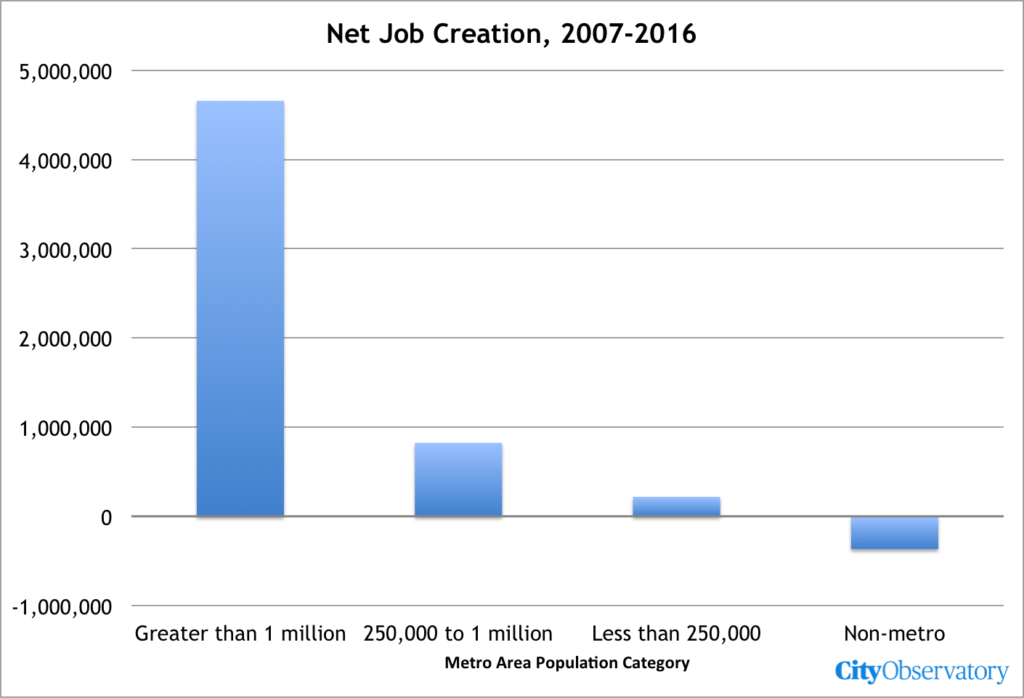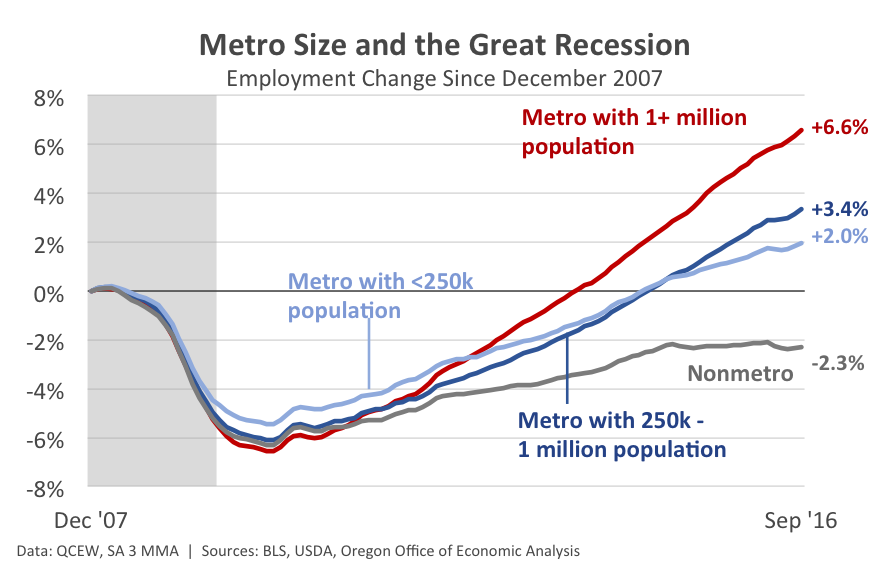The nation’s largest city-centered metro areas are powering national economic growth.
2017 will mark a decade since the peak of the last economic cycle (which according to the National Bureau of Economic Research was December 2007. Since then, we’ve experienced the Great Recession (the biggest economic downturn in eight decades), and a long and arduous recovery.
We’ve always maintained that the word “recovery” is a misleading term, because it seems to imply that we get back exactly the same economy, industries and jobs that we lost to the recession. In fact, that’s not true: the jobs created since the bottom of the recession in 2009 are in different firms, in different industries, and importantly, in different places than the jobs we lost to the recession.
It’s illuminating to look to see where the jobs that have been created in this recovery are actually located. There’s no question that large metros are important to the economy. These 51 metros with a million or more population are home to 168 million Americans, and account for about 65 percent of the nation’s gross domestic product. But the big question is, how important are they to national growth? It turns out that in this particular recovery, big city metros, those with a population of 1 million or more, have dramatically outperformed the rest of the nation’s economy.
Today we’re revisiting a data series that has been compiled and tracked by our friend Josh Lehner, an economist in the Oregon Office of Economic Analysis. Josh uses Bureau of Labor Statistics employment data to track employment growth by size of metropolitan area. His analysis divides the nation into four groups: the 51 metropolitan areas of 1 million population or more, two groups of mid-sized and smaller metropolitan areas, and nonmetropolitan America.
The latest data show that, as a group, large metropolitan areas have dramatically out-performed the rest of the country in the last economic cycle (dating from the peak of the economy in December 2007). In the aggregate, metros with 1 million or more population have fully recovered the employment lost in the Great Recession, and grown to 6.6 percent above their pre-recession peak. As of September, 2016, smaller and mid-sized areas, collectively were about 2-3 percent above their 2007 peak level of employment. And non-metropolitan America is still 2.3 percent below where it was in 2007.
Here’s another way to think about this same data. As of September 2016, total U.S. employment was up about 5.3 million jobs from the previous peak recorded in December 2007 (133.03 million jobs in 2007; 138.37 million jobs in 2016). The fifty-one largest metropolitan areas recorded an increase of 4.66 million jobs between 2007 and 2016. Collectively, these big city metro’s accounted for about 87 percent of the net job growth nationally.

This time is different
What’s new and different here is that big city metros haven’t been the one’s that have driven US economic growth in previous cycles. It’s usually the case that small and mid-sized metros, as a group, have grown faster than big city metros. Using Josh’s data, we prepared a second chart, showing the growth in employment for large, middle-sized and small metros and non-metros, for the period 2002 through 2007. During that growth period, small and mid-sized metros decidedly out-performed larger metros in job growth. The smallest metros grew their employment by 7.5 percent, mid-sized metros grew about 6.5 percent, and large metros grew about 5.5 percent.
As we’ve pointed out in our report, Surging City Center Job Growth, the last few years have witnessed a historic reversal in the patterns of job growth within large metropolitan areas. After decades of steady decentralization, employment growth in urban centers substantially outpaced that in more peripheral locations from 2007 through 2011. We think there’s strong evidence that this process is driven by employers looking to tap the growing labor market in city centers, which itself is a product of the movement of well-educated young adults back to cities (as we documented in Young and Restless).
All this evidence points to one thing: City centers are the big drivers of national economic growth. Big metros are significantly out-performing smaller metros, which in turn are out-performing rural areas. Within large metros, the decades-long pattern of job decentralization has reversed—and jobs are growing faster in city centers than in the metropolitan periphery. In this economic expansion, the nation’s economic growth is tied to the performance of its large metros and their robust city centers.
Many thanks to Josh Lehner for compiling this data and sharing it. Be sure to visit the Office of Economic Analysis blog for more detail, including a national map showing patterns of county-level job growth since 2007.


